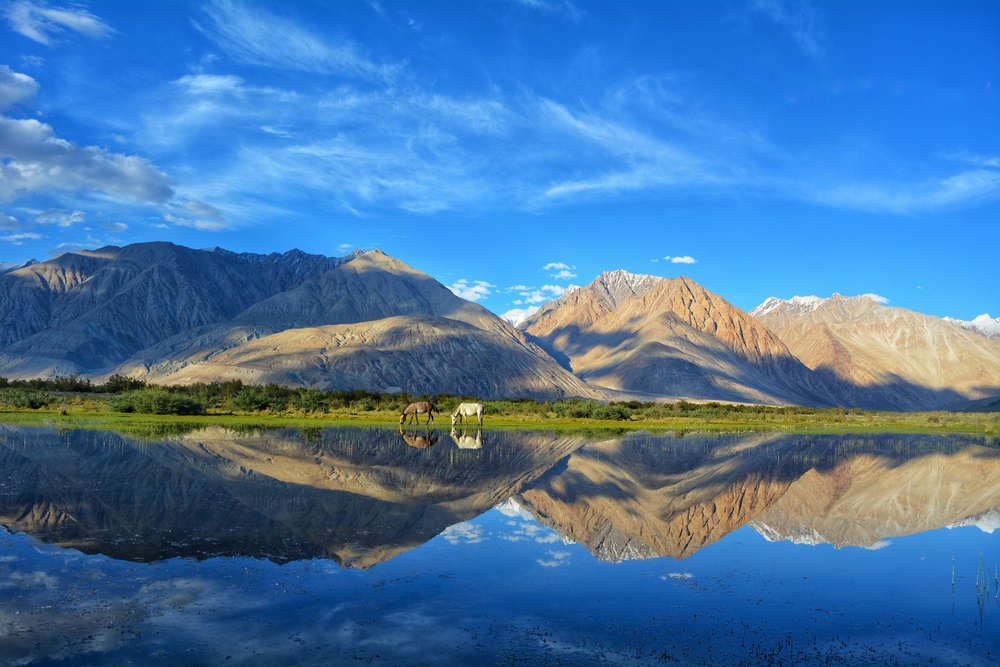Ladakh Tourism has captured the imagination of travellers worldwide with its surreal landscapes, ancient monasteries, rugged mountains, and pristine blue lakes. Known as the Land of High Passes, Ladakh is located in the northernmost part of India, offering an unparalleled blend of natural beauty, adventure, and spirituality that makes it a dream destination for every traveller.
One of the prime attractions of Ladakh Tourism is Leh, the capital city, which serves as the gateway to exploring the entire region. Leh is dotted with Buddhist monasteries, vibrant markets, and historic sites. The Leh Palace, resembling Lhasa’s Potala Palace, offers panoramic views of the town and surrounding mountains. Nearby, the Shanti Stupa, a white-domed structure built by Japanese monks, is a symbol of peace and provides breathtaking sunset and sunrise views over Leh.
Ladakh Tourism is synonymous with its ancient monasteries, which are centres of spirituality, culture, and art. Hemis Monastery, the largest and wealthiest monastery in Ladakh, is famous for its annual Hemis Festival featuring masked dances that depict the victory of good over evil. Thiksey Monastery, resembling Tibet’s Potala Palace, houses a magnificent 15-metre high statue of Maitreya Buddha. Other important monasteries include Diskit, known for its giant Maitreya Buddha statue overlooking Nubra Valley, and Alchi Monastery, famous for its ancient frescoes and wood carvings.
Pangong Lake is one of the most iconic highlights of Ladakh Tourism. Situated at an altitude of 14,270 feet, this endorheic lake extends from India to China and is renowned for its changing shades of blue. The mesmerising beauty of Pangong Lake, especially during sunrise and sunset, attracts tourists, photographers, and filmmakers, as seen in Bollywood movies like 3 Idiots. Camping by the lake under a starry sky is an experience that remains etched in travellers’ hearts forever.
Another must-visit destination under Ladakh Tourism is Nubra Valley, located north of Leh. Known as the Valley of Flowers, Nubra is accessible via Khardung La Pass, one of the highest motorable roads in the world at 18,380 feet. The valley is famous for its cold desert at Hunder, where visitors can enjoy unique double-humped Bactrian camel rides on sand dunes surrounded by mountains. Diskit Monastery, with its colossal Buddha statue, offers panoramic views of the valley and is an important spiritual site.
Tso Moriri Lake, situated in the Changthang region, is another gem of Ladakh Tourism. This high-altitude lake, surrounded by barren hills and snow-capped peaks, is less crowded than Pangong, making it ideal for travellers seeking solitude. It is a designated wetland reserve and attracts migratory birds like bar-headed geese and Brahminy ducks, adding to its pristine beauty.
For adventure seekers, Ladakh Tourism offers thrilling activities like trekking, river rafting, and motorbiking. The Markha Valley Trek is among the most popular treks, taking trekkers through remote villages, high passes, and breathtaking landscapes with views of Kang Yatse and Stok Kangri peaks. Chadar Trek on the frozen Zanskar River is another unique experience where trekkers walk over sheets of ice amidst dramatic gorges during winter. River rafting in the Zanskar and Indus rivers provides an adrenaline rush with stunning Himalayan backdrops.
Motorbiking on the Manali-Leh or Srinagar-Leh highway is a dream for bikers. Riding through high mountain passes like Rohtang La, Baralacha La, Tanglang La, and Khardung La offers a sense of adventure unmatched anywhere else. These journeys showcase the rugged charm of Ladakh Tourism, making it an unforgettable expedition.
Ladakh is also rich in culture and festivals. The Ladakh Festival, held in Leh in September, showcases traditional dances, music, archery, and polo matches, reflecting the region’s vibrant heritage. Losar, the Tibetan New Year, is another important festival celebrated with great zeal and rituals in monasteries across Ladakh.
The Magnetic Hill, near Leh, is a fascinating spot under Ladakh Tourism. This optical illusion creates an effect where vehicles appear to move uphill against gravity when parked at a designated spot, surprising every traveller who experiences it.
Another spiritual site under Ladakh Tourism is the confluence of the Indus and Zanskar rivers at Nimmu. The striking contrast between the blue-green Indus and the muddy Zanskar makes it a picturesque stop for photography and river rafting adventures.
In recent years, Ladakh Tourism has also promoted eco-tourism and sustainable travel. Homestays in remote villages like Turtuk, Likir, and Basgo offer authentic experiences of Ladakhi life, traditional cuisine, and warm hospitality while supporting local communities.
Ladakh’s cuisine, a reflection of its Tibetan and Central Asian influences, adds to the tourism experience. Dishes like Thukpa (noodle soup), Momos (dumplings), Skyu (traditional pasta), Butter Tea, and Apricot jam reflect the unique flavours of this high-altitude desert region.
In conclusion, Ladakh Tourism is not just about visiting destinations; it is about experiencing a land where nature’s grandeur, spiritual depth, and adventurous spirit come together. Whether it is watching the changing colours of Pangong Lake, trekking through remote valleys, meditating in ancient monasteries, or riding on the world’s highest roads, Ladakh promises a journey that awakens the soul and leaves an everlasting impression. It is truly a destination that justifies its title as Heaven on Earth.





